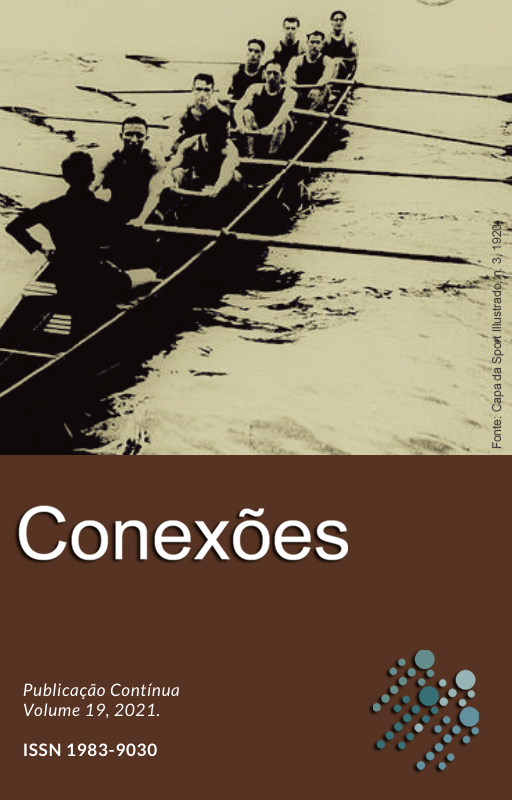Abstract
Introduction: The article deals with language and its entanglements with the theme of the body and the pedagogical responsibility of Physical Education within the Area of Languages. Methodology: It has as reference a critical-hermeneutical perspective of a bibliographic nature, it retrieves fundamental concepts of Western culture, such as physis, logos, pathos, it resorts the legal frameworks of Basic Education in Brazil. Results and discussion: It recognizes, in objectifications in practical situations linked to the senses, the dignity of different forms of language. Not limiting itself to the universe of a scientific reason, nor to the immediacy of sensitive impulses, it maintains that the languages that make us human are strained between logos and pathos. Referring to the specificity of the area of languages, it highlights the formative character of these languages, by giving space for sensitivity channels to emerge beyond the cognitive-conceptual. Final considerations: It affirms the body as the basis of our understanding and compreheension of the world, which requires a worldly reason that dialogues with contexts and is capable of building a common world. It bets that knowledge, emerging from language experiences, allows an ethical-aesthetic, expressive and reflective knowledge, in a relationship of belonging and estrangement with tradition.
References
BRASIL. Resolução nº 7, de 14 de dezembro de 2010. Fixa Diretrizes Curriculares Nacionais para o Ensino Fundamental de 9 (nove) anos. 2010a. Disponível em: http://portal.mec.gov.br/dmdocuments/rceb007_10.pdf. Acesso em: 1º out. 2020.
BRASIL. Conselho Nacional De Educação. Resolução nº 04, de 13 de julho 2010b. Diretrizes Curriculares Nacionais Gerais para a Educação Básica. Diário Oficial da República Federativa do Brasil. Brasília, DF, 09 jul. 2010. Seção 1, p. 10. Disponível em: http://portal.mec.gov.br/index.php?option=com_content&view=article&id=17417&Itemid=866. Acesso em: 1 out. 2020.
BRASIL. Resolução nº 2, de 30 de janeiro de 2012. Define Diretrizes Curriculares Nacionais para o Ensino Médio. Diário Oficial da República Federativa do Brasil, Brasília: Ministério da Educação; Conselho Nacional de Educação; Câmara de Educação Básica, 2012. Disponível em: http://portal.mec.gov.br/index.php?option=com_content&view=article&id=17417&Itemid=866. Acesso em: 1 out. 2020.
BRASIL. Secretaria de Educação Fundamental. Parâmetros curriculares nacionais: introdução aos parâmetros curriculares nacionais. – Brasília: MEC/SEF, 1997. 126p. Disponível em: http://portal.mec.gov.br/seb/arquivos/pdf/livro01.pdf. Acesso em: 1 out. 2020.
BRASIL. Lei 9.394/96 de 20 de dezembro de 1996. Disponível em: http://portal.mec.gov.br/seesp/arquivos/pdf/lei9394_ldbn1.pdf. Acesso em: 26 out. 2020.
BRASIL. Lei 5.692/1971. Trata das Diretrizes e Bases da Educação Nacional. Disponível em: http://portal.mec.gov.br/. Acesso em: 26 out. 2020.
BRASIL. Lei de Diretrizes e Bases da Educação Nacional. Lei nº 4.024, de 20 de dezembro de 1961. Disponível em: http://www.planalto.gov.br/ccivil_03/leis/l4024.htm. Acesso em: out. 5 out. 2020.
BRASIL. Base Nacional Comum Curricular (BNCC). Disponível em: http://basenacionalcomum.mec.gov.br/. Acesso em: 1º out. 2020.
BRECHT, Bertold. “Se os tubarões fossem homens.” Resistir Info, maio. 2005. 1 site. Disponível em: http://resistir.info/brecht/tubaroes_homens.html. Acesso em: 20 jun. 2020. Acesso em: 10 out. 2020.
BORGES, Jorge Luis. Una brújula. "Poesia Completa" Debolsillo. 3. ed. 2016. p. 183. Disponível em: https://www.escritas.org/pt/t/50964/una-brujula.
ECO, Umberto. ECO – Entrevista de Roger Pol Droit ("LE MONDE"). Folha de São Paulo, Caderno +mais. São Paulo, domingo, 3 abr. 1994. Tradução Clara Allain. Disponível em: https://www1.folha.uol.com.br/fsp/1994/4/03/mais!/9.html. Acesso em: 13 nov. 2020.
FERRANTE, Elena. Entrevista a Luiz Zanin Oricchio. Caderno de cultura do Jornal O Estado de São Paulo, 30 de agosto de 2020. Disponível em: https://cultura.estadao.com.br/noticias/literatura,critica-a-vida-mentirosa-dos-adultos-reafirma-paixao-e-coragem-na-voz-de-elena-ferrante,70003418999. Acesso: 23 out. 2020.
GADAMER, Hans-Georg. Verdade e método I: traços fundamentais de uma hermenêutica filosófica. Tradução Flávio Paulo Meurer. 3. ed. Petrópolis, RJ: Vozes, 1999.
GADAMER, Hans-Georg. Verdade e método II: complementos e índices. Tradução Enio Paulo Giachini. Revisão tradução de Márcia Sá Cavalcante Schuback. 2. ed. Petrópolis, RJ: Vozes, 2004.
GRONDIN, Jean. Retrospectiva Dialógica à obra reunida e sua história de efetuação. In: ALMEIDA, Custódio Luís S. de; FLICKINGER, Hans-Georg; ROHDEN, Luiz. Hermenêutica filosófica. Nas trilhas de Hans-Georg Gadamer. Porto Alegre: EDIPUCRS, 2000. p. 203-222. (Coleção filosofia, 117).
GONZÁLEZ, Fernando J.; JOHANN, Maria R.; POSSANI, Taíse N. Área das linguagens na educação básica: conhecimento e especificidade. In: GASTALDO, Luiz F.; ARENHART, Lívio O.; ANGST, Francisco (Org.). Formação continuada macromissioneira. Tubarão: Ed. Copiart, 2015. p. 453-468.
HEIDEGGER, Martin. A época da imagem do mundo. Tradução Paulo Rudi Schneider. In: SCHNEIDER, Paulo Rudi. O outro pensar: sobre o que significa pensar? e A época da imagem do mundo. Ijuí: Editora Unijuí, 2005. (Coleção filosofia; 17).
HEIDEGGER, Martin. Ser e tempo. Petrópolis, RJ: Vozes, 1988. Parte I.
HERMANN, Nadja. O enlace entre corpo, ética e estética. Revista Brasileira de Educação, v. 23, e230051, 2018. Disponível em: https://www.scielo.br/scielo.php?script=sci_abstract&pid=S1413-24782018000100243&lng=pt&nrm=iso
KUNZ, Elenor. Se movimentar. In: GONZÁLEZ, Fernando J.; FENSTERSEIFER, Paulo E. (Org.). Dicionário crítico de educação física. 3. ed. revisada e ampliada. Ijuí, RS: Editora Unijuí, 2014. p. 608-610.
LENINE, Oswaldo. Paciência. 1999. Disponível em: https://www.letras.mus.br/lenine/47001/. Acesso em: 10 out. 2020.
NUNES, Benedito. Hermenêutica e poesia. O pensamento poético. Organização Maria José CMPOS. Belo Horizonte: Ed. UFMG, 2007.
ROHDEN, Luiz. Hermenêutica e linguagem. In: ALMEIDA, Custódio Luís S. de; FLICKINGER, Hans-Georg; ROHDEN, Luiz. Hermenêutica filosófica. Nas trilhas de Hans-Georg Gadamer. Porto Alegre: EDIPUCRS, 2000. p. 151-202. (Coleção filosofia, 117).
SAFATLE, Vladimir. Há situações em que é imoral pensar? O duplo fundamento insuficiente do ato moral. In: NOVAES, Adauto (org.). Mutações. A experiência do pensamento. São Paulo: Edições Sesc SP, 2010. p. 133-155.
SAVATER, Fernando. O valor de educar. Tradução Monica Stahel. São Paulo: Martins Fontes, 1998.

This work is licensed under a Creative Commons Attribution-NonCommercial 4.0 International License.
Copyright (c) 2021 Paulo Evaldo Fensterseifer, Maria Regina Johann


